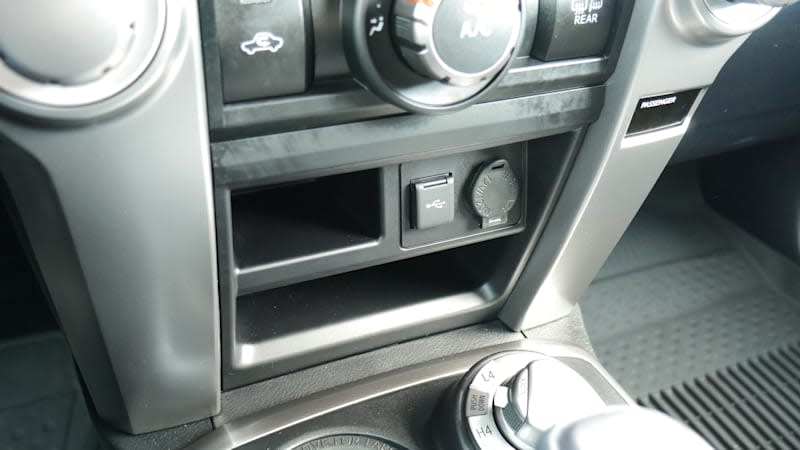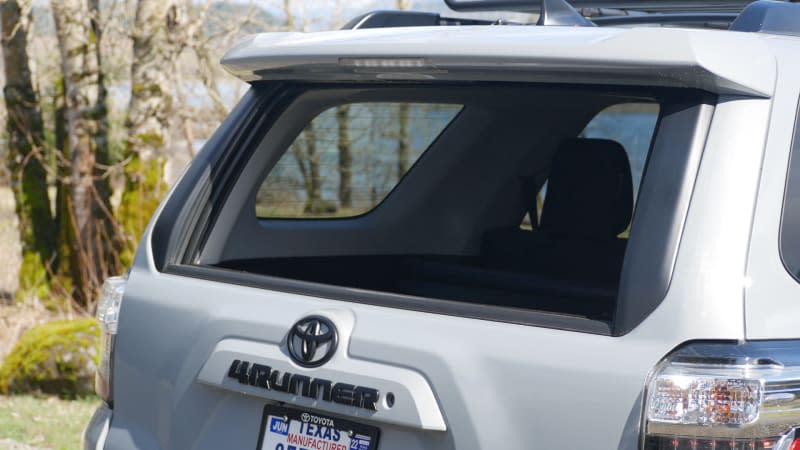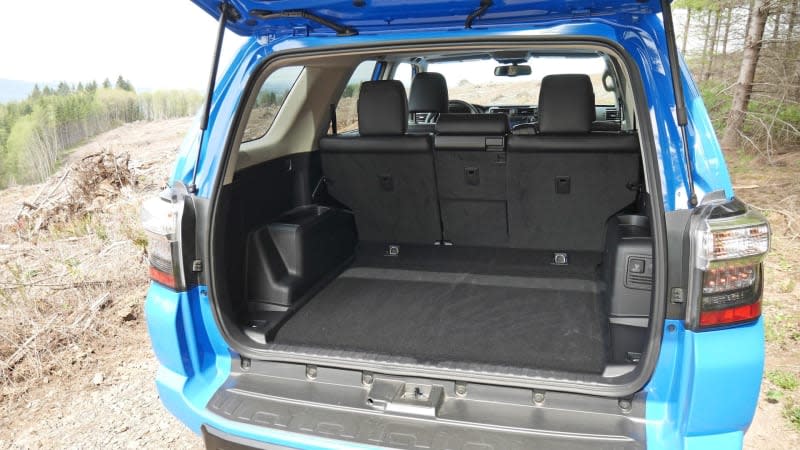2023 Toyota 4Runner Review: 14 going on 40

Pros: Tried-and-true mechanicals; cargo-carrying champ; roll-down rear window; multiple variants
Cons: Slow; inefficient; imprecise handling; antiquated interior
The Toyota 4Runner has been kicking around now for 40 years. For the majority of that time, new generations would dawn every six years, injecting Toyota’s midsize SUV with a fresh design and more refinement. For the past 14 years, though, including the 2023 Toyota 4Runner, we’ve been graced with generation five. Basically, there should’ve been two new 4Runners by now, and although there have been needed upgrades and welcome additions, you can totally tell.
Now, being ancient isn't all bad: It has the same rugged truck-based chassis, capable suspension, ample clearances and bulletproof reliability that make it a darling among off-roaders everywhere (and keep its residual values sky-high). Its abundant interior space has also allowed it to be a realistic alternative to more family-friendly midsize crossovers. And, frankly, new cars can be awfully complicated. A simpler one will be mighty appealing to a lot of people.
On the other hand, there's no escaping the ravages of father time (and all its competitors being redesigned/introduced in the past few years). Its V6 engine has less power than a Camry's, the transmission has five (!) fewer gears than a Ford Bronco's, the fuel economy of 17 mpg combined is dismal even when compared to Broncos and Wranglers, and calling the handling "imprecise" would be an understatement. The interior, despite those upgrades and its generous space, is still a relic of another time. As such, the 4Runner won't make sense for everyone, and the introduction of the Bronco (if you can actually get one) means there's one more competitor to make the 4Runner look its age.
Interior & Technology | Passenger & Cargo Space | Performance & Fuel Economy
What it's like to drive | Pricing & Trim Levels | Crash Ratings & Safety Features
What's new for 2023?
For one year only (naturally), the 4Runner 40th Anniversary Edition will be offered. It takes the modest SR5 Premium trim and adds bronze 17-inch wheels, TRD-style TOYOTA grille, special badging and the way-cool yellow/orange/red body striping on a choice of white, black or Barcelona Red. Only 4,040 will be available. The similarly equipped Trail Edition, pictured above, would seem to be on hiatus along with its special Army Green and Cement paint choices for 2023. Other updates include LED headlights and blind-spot and rear cross-traffic warning added to all trim levels. There’s also the annual tradition of a new, one-year-only TRD Pro color: Solar Octane orange replaces last year’s eye-searing Lime Rush, which is now an option on the TRD Off-Road.
What are the 4Runner interior and in-car technology like?
After significant upgrades three years ago, the 4Runner cabin's feature content and technology are reasonably consistent with what you might find in cars designed during this decade. That said, this remains an antiquated interior with its blocky design that dates back to Barack Obama's first year in office. The plastics quality is also subpar for a vehicle that easily crests $40,000 and can top $50,000 – a RAV4 is nicer in some places. The various small bins and cubbies are also just a little too small for modern devices, having clearly been designed when we carried flip phones and iPods. There's even old-school switchgear like the roller heated seat controls and one-blink-only turn signals. The SR5, TRD Sport and 40th Anniversary Edition don't even have automatic headlights or auto climate control.
Nevertheless, it's all put together quite well, controls are logically placed, and there's certainly something to be said for a rugged off-road vehicle that has a rugged interior. The standard 8-inch touchscreen is also of a typical size and has an acceptable amount of feature content, with standard Apple CarPlay, Android Auto and Amazon Alexa integration. Simple tasks like changing radio stations are generally easy to perform (unlike Toyota’s new system), but it's slow to respond and antiquated in appearance (unlike Toyota’s new system). The Jeep Wrangler, and to a lesser extent Ford Bronco, put this infotainment system to shame.


How big is the 4Runner?
Here is an area where the 4Runner is perfectly fine as-is. The cargo area floor is quite low for a truck-based SUV, while the space beyond is a big, boxy 47.2 cubic feet. Even when you add the novel slide-out cargo floor that reduces capacity, there's still a gigantic amount of space. We know, we filled it up in our cargo area Luggage Test, and then found that it smoked its off-roader competition. Maximum cargo capacity with the back seat lowered is 89.7 cubic feet, which rivals many three-row crossovers (the Highlander has only 84.3) and surpasses various two-row models.
There are also clever cargo area features. The optional slide-out cargo floor makes loading and unloading super-simple, while the 4Runner-trademark power rear window allows you to secure long items like surf boards or lumber out the back while keeping the rest of the liftgate closed. It also allows for freer airflow in the cabin, and dogs typically love it as well (that big boxy area in general is dog friendly).
Human legroom is quite good all around. The standard power driver seat offers plenty of adjustment, while the back seat is mounted at a nice height and reclines to an almost absurd degree. That said, headroom can be a bit tight up front should you opt for the sunroof. There's a third-row seat available, but its space is extremely limited and it reduces cargo space. Really, if you want a third-row seat, crossovers like the Kia Telluride or Jeep Grand Cherokee L would be a better family-hauling choice.




What are the 4Runner fuel economy and performance specs?
While much of this fifth-generation 4Runner has been updated over the many years, the engine bay has basically gone untouched. That’s not a good thing. The 4Runner is only offered with a 4.0-liter V6 that produces 270 horsepower and 278 pound-feet of torque. That's not a lot given how much the 4Runner can weigh (especially the TRD Pro) and the fact that the lighter Toyota Highlander produces more than 300 horsepower. As such, the 4Runner is quite slow, and it's not helped by a standard five-speed automatic transmission that does it no favors in terms of fuel economy. A Bronco’s automatic has five(!) more gears (and there’s an optional manual).
According the EPA, the 4Runner returns 16 mpg city, 19 mpg highway and 17 mpg combined regardless of drivetrain, which is pretty bad given its weak-sauce power output. And it gets worse. The TRD Pro's off-road tires, heavier weight and blunter aerodynamics resulted in us averaging only 17 mpg in about 250 miles of highway driving in a TRD Pro. We saw the low teens around town. By contrast, we were seeing 18 to 19 mpg on the highway in the Trail Edition, which might not seem like a big difference, but it is.
The optional four-wheel drive system provides high and low range. It is selected with a traditional mechanical shifter on TRD models, while the SR5, TRD Sport and Trail Edition utilize a knob that engages the same transfer case with a servo. Basically, it's simpler to use and therefore friendlier for the less off-roading-versed owners more likely to buy those trim levels. The Limited also has the knob, but it controls a full-time four-wheel-drive system that includes a locking center differential.
Despite its rugged body-on-frame construction, every 4Runner's towing capacity is only 5,000 pounds.



 Yahoo Autos
Yahoo Autos 

